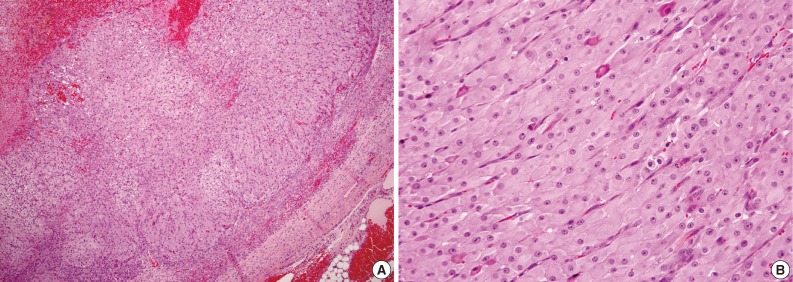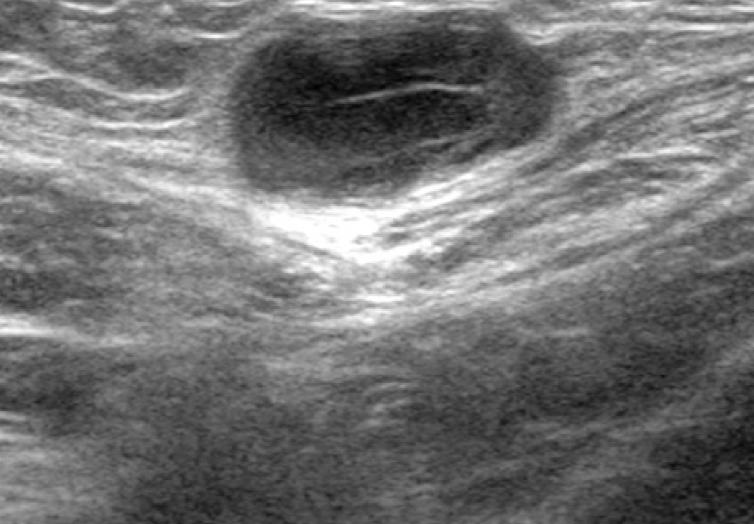Articles
- Page Path
- HOME > J Pathol Transl Med > Volume 47(3); 2013 > Article
-
Brief Case Report
Ovarian Remnant Syndrome at the Trochar Site: A Report of a Rare Complication Following Laparoscopic Ovarian Surgery - Ki Yong Na1,2, Ji-Youn Sung2, Kyu Yeoun Won3, Gou Young Kim3, Sung-Jig Lim3, Suk-Hwan Lee4
-
Korean Journal of Pathology 2013;47(3):304-306.
DOI: https://doi.org/10.4132/KoreanJPathol.2013.47.3.304
Published online: June 25, 2013
1Department of Pathology, Graduate School of Medicine, Kyung Hee University, Seoul, Korea.
2Department of Pathology, Kyung Hee University Medical Center, Seoul, Korea.
3Department of Pathology, Kyung Hee University Hospital at Gangdong, Kyung Hee University School of Medicine, Seoul, Korea.
4Department of Surgery, Kyung Hee University Hospital at Gangdong, Kyung Hee University School of Medicine, Seoul, Korea.
- Corresponding Author: Gou Young Kim, M.D. Department of Pathology, Kyung Hee University Hospital at Gangdong, Kyung Hee University School of Medicine, 26 Kyunghee-daero, Dongdaemun-gu, Seoul 130-701, Korea. Tel: +82-2-440-7551, Fax: +82-2-440-7564, pathogen@medimail.co.kr
© 2013 The Korean Society of Pathologists/The Korean Society for Cytopathology
This is an Open Access article distributed under the terms of the Creative Commons Attribution Non-Commercial License (http://creativecommons.org/licenses/by-nc/3.0/) which permits unrestricted non-commercial use, distribution, and reproduction in any medium, provided the original work is properly cited.
- A 35-year-old woman presented with an abdominal wall mass that was palpable one week prior to her visit. The mass was not painful and did not show a change in size. Her past medical history was remarkable because she had undergone laparoscopic bilateral ovarian cystectomy due to endometriosis 3 years prior to her visit. Physical examination revealed a surgical scar on her left lower abdomen and an index finger tip-sized mass was palpable in the abdominal wall under the scar. It was smooth and movable, and was not tender. The laboratory findings were unremarkable.
- Ultrasonography demonstrated an approximately 1.6×0.9 cm-sized hypoechoic mass in the subcutaneous adipose tissue (Fig. 1). An excisional biopsy was performed. The mass was well demarcated from the adjacent soft tissue by a thin fibrous capsule. The cut surface showed a yellow, glistening lobular parenchyma with areas of blood-filled cystic spaces. Histologically, the parenchyma was composed of luteinized granulosa and theca cell layers, suggesting corpus luteum of the ovary (Fig. 2). There was no evidence of endometriosis.
- A review of the operation record of the laparoscopic surgery that was performed 3 years prior showed that the patient had 5.4×4.5×4.0 cm- and 3.2×3.0×1.5 cm-sized endometriotic cysts in bilateral ovaries with an associated dense pelvic adhesion. After a cystectomy, the specimens were fragmented and extracted using forceps through the trochar on her left lower abdomen.
- The patient was discharged after the abdominal wall mass excision and was healthy with no recurrence of the lesion at a follow-up at 32 months.
CASE REPORT
- Ovarian remnant syndrome is a rare but gradually increasing complication after ovarian surgery. Patients with ovarian remnant syndrome often experience chronic constant or cyclic pelvic pain. As a diagnostic method, a clomiphen citrate stimulation test can be helpful. This test elicits ovarian follicular development in residual ovarian tissues and the structure change can be observed by serial ultrasonographic examination. Residual ovarian tissue has shown various histological spectra, such as normal ovarian cortex, corpus luteum, endometriosis and rarely, malignant transformation. The therapeutic choice of ovarian remnant syndrome is surgical resection of residual ovarian tissue. It is mostly curative and also prevents the possibility of malignant transformation. Therefore, ovarian remnant syndrome is an important differential diagnosis that should be considered and managed in patients with pelvic pain who underwent oophorectomy.1
- Several theories have been suggested to explain the occurrence of ovarian remnant syndrome during laparoscopic surgery, of which, implantation of ovarian tissue is the most important.2 Several experimental studies performed artificial implantation of ovarian tissue in animals. These studies have shown that implanted ovarian tissue can be revascularized without artificial vascular anastomosis and still be viable. Several growth factors such as fibroblast growth factor, transforming growth factor and vascular endothelial growth factor have been found to play a role in this process. Eventually, implanted ovarian tissue can undergo a normal ovarian cycle with a response to estrogen and progesterone.3
- Most cases of ovarian remnant syndrome after laparoscopic ovarian surgery have been caused by residual ovarian tissue in a pelvic cavity. To our knowledge, there have been only two cases that showed residual ovarian tissue on an abdominal wall. In the previous and present cases, clinical presentation, indication of previous surgery and histological findings of residual ovarian tissue were relatively typical (Table 1).
- In the case described by Marconi et al.,4 a piece of ovarian tissue remained in the patient's abdominal wall during operation. The author suggested that this piece was the source of residual ovarian tissue. In the case by Chao5 as well as the present case, the source of residual ovarian tissue was not determined but implantation of a tiny piece of ovarian tissue might occur during the extraction of the specimen through the trochar.4 These cases suggest that during specimen extraction after laparoscopic ovarian surgery, the risk of ovarian tissue implantation on the abdominal wall should be recognized and prevented. Several preventive methods have been suggested and include the use of large-diameter trochars, copious irrigation of the operation field, plastic bags and a vaginal approach with culdotomy.4,5
- In conclusion, we report a rare complication of laparoscopic ovarian surgery: implantation of ovarian tissue on the abdominal wall. The present case suggests that the risk of ovarian tissue implantation during extraction of the specimen after laparoscopic ovarian surgery should be recognized. In patients with ovarian remnant syndrome, surgical resection of residual ovarian tissue is mandatory and therefore, it is wiser to prevent the occurrence of such conditions.
DISCUSSION
- 1. Magtibay PM, Magrina JF. Ovarian remnant syndrome. Clin Obstet Gynecol 2006; 49: 526-534. ArticlePubMed
- 2. Nezhat CH, Seidman DS, Nezhat FR, Mirmalek SA, Nezhat CR. Ovarian remnant syndrome after laparoscopic oophorectomy. Fertil Steril 2000; 74: 1024-1028. ArticlePubMed
- 3. Demeestere I, Simon P, Emiliani S, Delbaere A, Englert Y. Orthotopic and heterotopic ovarian tissue transplantation. Hum Reprod Update 2009; 15: 649-665. ArticlePubMedPMC
- 4. Marconi G, Quintana R, Rueda-Leverone NG, Vighi S. Accidental ovarian autograft after a laparoscopic surgery: case report. Fertil Steril 1997; 68: 364-366. ArticlePubMed
- 5. Chao HA. Ovarian remnant syndrome at the port site. J Minim Invasive Gynecol 2008; 15: 505-507. ArticlePubMed
REFERENCES

Figure & Data
References
Citations

- Síndrome de ovario remanente. Revisión bibliográfica. Evidencia actual
M. Arnáez de la Cruz, J. Gallardo Martínez
Clínica e Investigación en Ginecología y Obstetricia.2023; 50(4): 100902. CrossRef - Clear cell carcinoma arising in an ovarian remnant 19 years after oophoerctomy: case report
Ting-ting Yao, Shao-jie Zhao, Bing Zhang
BMC Women's Health.2023;[Epub] CrossRef - Clear-Cell Carcinoma Developing in Remnant Ovary After Hysterectomy and Bilateral Salpingo-Oophorectomy for Endometriosis
Satoshi Ichigo, Hiroshi Takagi, Kazutoshi Matsunami, Takayuki Murase, Tsuneko Ikeda, Atsushi Imai
Journal of Gynecologic Surgery.2014; 30(2): 114. CrossRef - Malignant neoplasia arising from ovarian remnants following bilateral salpingo-oophorectomy (Review)
ATSUSHI IMAI, KAZUTOSHI MATSUNAMI, HIROSHI TAKAGI, SATOSHI ICHIGO
Oncology Letters.2014; 8(1): 3. CrossRef
 PubReader
PubReader ePub Link
ePub Link-
 Cite this Article
Cite this Article
- Cite this Article
-
- Close
- Download Citation
- Close
- Figure


Fig. 1
Fig. 2
| Case No. | Age (yr) | Route | Indication | Clinical presentation | Treatment | Pathologic finding |
|---|---|---|---|---|---|---|
| 1 | 38 | LOC | Endometriosis | Mass with cyclic change | Mass excision | Normal ovarian tissue |
| 2 | 22 | LO | Endometriosis | Painful mass | Mass excision | Endometriosis |
| Present case | 35 | LOC | Endometriosis | Mass | Mass excision | Corpus luteum |
LOC, laparoscopic ovarian cystectomy; LO, laparoscopic oophorectomy.

 E-submission
E-submission





